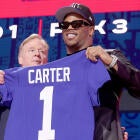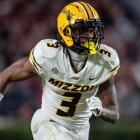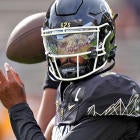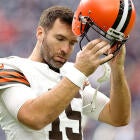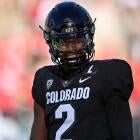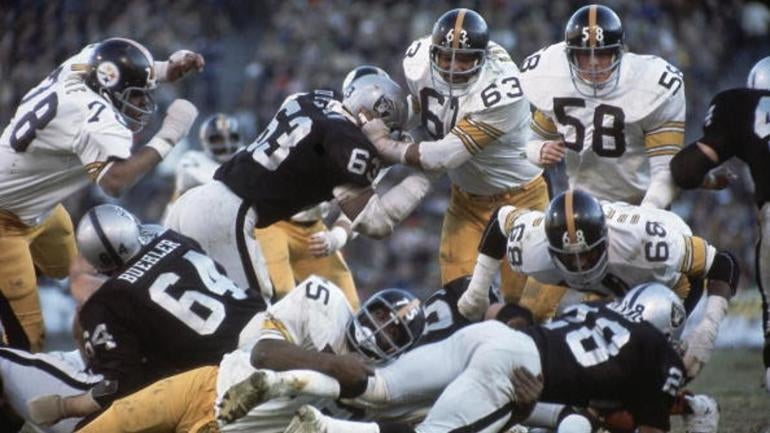
Sunday is going to be an electric night in Pittsburgh. Along with a compelling game between the New York Jets and Pittsburgh Steelers, the night will include 50th anniversary celebration of Pittsburgh's first Super Bowl team.
Several members of the 1974 Steelers will be in attendance on a night where their historic season will once again be recognized. Part of the celebration includes the current Steelers wearing special throwback jerseys with a patch honoring Pittsburgh's 16-6 victory over the Minnesota Vikings in Super Bowl IX, the first of a record-tying six Super Bowls won by the Steelers.
We've decided to join in the celebration by naming 50 facts on the 1974 Steelers season, one that ushered in one of the greatest dynasties in NFL history.
1. The Steelers' 1974 rookie class featured a record five Hall of Famers in receiver Lynn Swann, linebacker Jack Lambert, center Mike Webster, receiver John Stallworth, and safety Donnie Shell, who was signed as an undrafted free agent.
2. A year earlier, the Steelers were the subject of a unique book that invited the reader to get an inside look at an NFL team during a season. The book was appropriately titled, "About Three Bricks Shy of a Load," as the Steelers were close but not yet a championship team.
3. Pittsburgh went 6-0 during the preseason (yes, teams played in six preseason games back then).
4. In Week 1, Joe Gilliam became the Steelers' first Black starting quarterback. He threw two touchdown passes in Pittsburgh's 30-6 win over the Colts.
5. A week later, Gilliam threw for 348 yards in Denver, but the Steelers had to settle for an unsatisfying tie after the defense surrendered 35 points, the most points it would allow that season.
6. Terry Bradshaw, the Steelers' future Hall of Fame quarterback, did not make his first start that season until Week 8. Replacing an ineffective Gilliam, Bradshaw put up decent numbers as the Steelers recorded a 27-0 win over the Eagles to improve to 6-1-1 on the season.
7. Bradshaw went back to the bench a week after the Steelers lost a 17-10 decision in Cincinnati. Backup Terry Hanratty completed just 2 passes a week later in Cleveland, but Pittsburgh still won on the strength of Franco Harris' 156 yards and a defense that forced seven turnovers.
Happy Birthday J.T. Thomas
— Old Time Football 🏈 (@Ol_TimeFootball) April 22, 2022
Thomas scores on a fumble recovery vs the Browns 1974.#Steelers win in Cleveland for the first time in 10 years#Steelers pic.twitter.com/TO6lwEgs3z
8. Against the Saints the following week, Bradshaw returned the lineup and ran for 99 yards and a score as Pittsburgh prevailed on "Monday Night Football." The win occurred in Tulane Stadium, the host site of that year's Super Bowl.
Week 11, 1974#Saints #Steelers on MNF
— Old Time Football 🏈 (@Ol_TimeFootball) February 22, 2020
Bradshaw 8-19-80-2-2
Scott 8-22-108-1@francoharrishof 19-114
Lewis 2-42-1
28-7 #Steelers #1974SteelersThread pic.twitter.com/e32Wmt8a7h
9. The turning point in Pittsburgh's season occurred a week later following a 13-10 loss to the Oilers in Week 12. Instead of changing quarterbacks again, Steelers coach Chuck Noll stuck with Bradshaw for the following week's crucial road game against the Patriots.
10. Bradshaw rewarded Noll's faith in him by throwing the game-clinching touchdown pass as the Steelers clinched the AFC Central division title and a spot in the playoffs.
11. The Steelers finished the regular season with a 10-3-1 record after defeating the Bengals in Week 14. Many pundits tabbed Pittsburgh as the AFC's third-best team entering the postseason, behind the Raiders and the two-time defending champion Dolphins.
12. Joe Greene was named Defensive Player of the Year for the second time in a three-year span. The future Hall of Fame defensive tackle anchored a defense that tallied 52 sacks, recovered 35 fumbles, picked off 25 passes, finished second in the NFL in points allowed and first in passing yards allowed.
November 17, 1974
— Kevin Gallagher (@KevG163) November 18, 2023
Mean Joe Greene's only career regular-season interception in a 26-16 #Steelers win at Cleveland
The stud PFHOF defensive tackle would collect another interception eight weeks later against the Vikings in Super Bowl IX. pic.twitter.com/4EYlO80dFd
13. Greene almost left the Steelers, though, following the late-season loss to Houston. But Lionel Taylor, the team's receivers coach, convinced Greene that better days were ahead for the Steelers.
14. Despite being under criticism most of the year, the Steelers offense still finished the '74 season No. 6 in the NFL in points scored. The offense was largely carried by Harris, who broke the 1,000-yard barrier despite being hampered by an injury earlier in the year.
15. Pittsburgh's sack leader during the regular season was defensive tackle Ernie Holmes, a valued member of the team's vaunted "Steel Curtain" defensive line. Known as "Fats," Holmes tallied 11.5 sacks, just ahead of fellow "Steel Curtain" member L.C. Greenwood, who recorded 11 sacks. Greene, who often took on double teams, still managed to get nine sacks to his credit.
16. Combined, Gilliam, Bradshaw, and Hanratty combined to complete just 43% of their passes during the regular season. The trio threw 12 touchdowns against 21 interceptions.
17. Frank Lewis, a future Pro Bowl receiver for the Bills, finished the regular season as Pittsburgh's leading receiver with just 365 yards and four touchdowns on 30 receptions.
18. Swann, the team's first-round pick, didn't contribute much to the offense, but he was a huge contributor on special teams. He led the NFL with 577 punt return yards that included a 64-yard return for a score against the Saints.
19. Three Steelers tied for the team lead in interceptions with 5: safety Glen Edwards, linebacker Jack Ham and cornerback J.T. Thomas. Ironically, Hall of Fame cornerback Mel Blount was tied for fourth on the team with two picks, the same number Lambert recorded.
20. Bobby Walden, the veteran punter, was the Steelers' oldest player at 36 years young. Walden was one of just five players from Noll's original team that were part of the '74 Steelers.
21. The other four: Greene, Greenwood, running back Rocky Bleier and seven-time Pro Bowl linebacker Andy Russell.
22. Along with Greenwood and Hines Ward, Russell is considered one of Pittsburgh's best players who is not in the Hall of Fame. Russell, who toiled on losing Steelers teams in the '60s, is credited with playing a big role in mentoring future Hall of Fame linebackers Russell and Lambert.
23. Speaking of underrated Steelers, tight end Randy Grossman made the Steelers roster that season as an undrafted rookie. While his name is often not mentioned when Pittsburgh's historic 1974 rookie class is discussed, Grossman was a key member of each of Pittsburgh's four Super Bowl teams during the decade. He caught a big touchdown pass in Super Bowl X and was the team's third leading receiver during the '78 season.
24. The '74 Steelers had six Pro Bowlers: Greene, Greenwood, Russell, Ham, Harris and kicker Roy Gerela. Greene, Greenwood, Ham were tabbed as All-Pros.
25. Pittsburgh opened the playoffs with a 32-14 trouncing of the Bills. The Steelers held Hall of Fame running back O.J. Simpson to 49 yards on 15 carries in his only career playoff game. Simpson did catch three passes for 37 yards and a touchdown.
26. Harris scored three touchdowns against the Bills, but the game was a coming-out party of sorts for Bradshaw, who threw for over 200 yards that included a 27-yard touchdown pass to Bleier. Bradshaw also ran for just one less yard than Simpson.
27. Along with Bradshaw and Harris, Bleier also had a big game against the Bills. He led the Steelers with 54 yards receiving and in total yards from scrimmage (109).
28. The win marked the second home playoff win in franchise history. The first was Pittsburgh's dramatic 13-7 win over the Raiders in the '72 divisional round in game that will forever be known by Harris' "Immaculate Reception."
The 1st Steelers-Bills playoff game
— Steel City Star (@steelcitystar) January 9, 2024
1974 AFC Divisional in Three Rivers Stadium
For the first time ever, digitally enhanced NFL Films footage combined with Don Criqui’s radio call.
The 2nd post-season win in Steelers history and their first SB year. pic.twitter.com/Y9ipMMvvkD
29. The Steelers AFC Championship game opponent, the Raiders, dethroned the Dolphins in the divisional round following Clarence Davis' "Sea of Hands" touchdown catch. The Raiders had defeated the Steelers, 17-0, back in Week 3, and the general consensus was that Oakland would defeat Pittsburgh en route to reaching Super Bowl IX.
30. After his team's win over Miami, Raiders coach John Madden declared the Raiders and Dolphins as the best two teams in football and that that game was the de facto Super Bowl. That didn't sit well with Noll, who broke character while delivering a rare pregame speech.
"In our meeting," Greene recalled, "Chuck said, well, fellas, the Super Bowl wasn't played yesterday, it's going to be played in two weeks and the best team in football is sitting right here in this room. It just kind of levitated us out of our seat and everybody let up a big whoop and it was a done deal."
31. The 1974 AFC Championship game featured 20 future Hall of Famers, 10 on both teams. The '74 Raiders offense is historic, with more Hall of Famers in its lineup (7) than any other unit in the Super Bowl era. The offense was led by Hall of Fame quarterback Ken Stabler, that year's league MVP, three Hall of Fame pass catchers and three Hall of Fame linemen.
32. Despite all of that firepower, the Raiders offense had little success that day. Led by Greene, the Steelers held the Raiders to 15 first downs and 278 total yards while picking off Stabler three times. Ham, whose 32 career picks is tied for third-most all time among linebackers, had two of those picks.
33. The most glaring number from the AFC title game was 29, which was the among of rushing yards Pittsburgh allowed. The Raiders averaged 167 rushing yards during the regular season, but they averaged just 1.38 yards per carry in the '74 AFC title game.
34. With his running game nonexistent, Stabler attacked Pittsburgh's defense. He attempted 36 passes (a bunch in those days) and threw for nearly three times as many yards as Bradshaw. His favorite target that day was future Hall of Fame wideout Cliff Branch, whose 38-yard touchdown catch against Blount gave the home team a 10-3 third-quarter lead.
35. After scoring just three points through three quarters, the Steelers dominated the fourth quarter, outscoring the Raiders 21-3 during the game's final 15 minutes. Harris got things going with an 8-yard touchdown run. Swann then gave the Steelers the lead for good when he caught a 6-yard bullet from Bradshaw in the back middle of the end zone. After a Raiders field goal, a 21-yard touchdown run by Harris put the game out of reach, clinching Pittsburgh's first trip to the Super Bowl.
36. While the Raiders couldn't run the ball that day, the Steelers offense ran all over Oakland's defense. Harris ran for 111 yards on 29 carries. Bleier added 98 yards on 18 carries, as Pittsburgh's offensive line imposed their will on the Raiders defense.
37. Years after Pittsburgh's 24-13 victory over Oakland, Harris said that that win was, "the biggest game for the '70s teams. It made us realize that we're a really good football team, and right now, we're probably the best. And that really set the tone for what was to come for the rest of that decade."
ESPN Primetime mock-up of…
— Steel City Star (@steelcitystar) December 29, 2023
The 1974 AFC Championship
Considered by many, including Franco, to be the biggest game of the Steelers’ 1970’s dynasty.
Of the 5 playoff games between the Raiders and Steelers in the 1970s, this is the only game won by the road team.
OTD in 1974 pic.twitter.com/SANVioungq
38. Back then, teams that had Super Bowl experience were usually the betting favorite. But despite the fact that Bud Grant's Vikings had already been in two Super Bowls (including the previous year), they were three-point underdogs to the Steelers entering Super Bowl IX. The over/under was set at 33 points.
39. Minnesota had already lost two Super Bowls and was trying to avoid becoming the first team to lose the big game in consecutive years. While they struggled in Super Bowls, Minnesota was one of the NFC's dominant teams throughout the '70s. Led by quarterback Fran Tarkenton and defensive end Alan Page, the Vikings won a whopping 69.4% of their regular-season games during the decade.
40. Super Bowl IX was supposed to be the first Super Bowl to be played inside a dome. But the Superdome was unfinished, so the game was instead played at Tulane Stadium, which had already hosted two Super Bowls. Of the Super Bowls played to that point, Super Bowl IX had the worst weather yet. It was windy, cold (the temperature was around 50 degrees throughout the game) and was played on a water-logged field after a storm had gone through the area earlier in the day.
41. Speaking of weather, Steelers defensive tackle Dwight White was under the weather throughout the week. He spent several days in the hospital after getting pneumonia and had lost nearly 20 pounds. White's own teammates didn't know whether or not he would play as he took part in pregame warmups despite his weakened state.
42. While not only played, he recored the first safety in Super Bowl history when he tagged Tarkenton in the end zone to break a scoreless tie in the second quarter. That turned out to be the only score of the first half in what is still the smallest halftime lead for a team in a Super Bowl.
Super Bowl IX - 1/12/75
— Dave Dameshek (@Dameshek) January 13, 2023
Steelers take 2-0 lead.
Listen to Cope here - what a call!
@steelers @SteelersHistory pic.twitter.com/N7QdVc6j3O
43. As they had against Oakland, the Steel Curtain completely shut down the Vikings' rushing attack. The Vikings' 17 yards on the ground that day (on 21 carries) is the second fewest rushing yards by a team in Super Bowl history. The '85 Patriots are the only team to run for fewer yards in a Super Bowl (7 on 11 carries in Super Bowl XX).
44. Also similar to their game against Oakland, Pittsburgh's ground game was running on all cylinders, led by Harris, who won MVP honors after running for then-Super Bowl records 158 yards on 34 carries. Harris scored the Steelers' first touchdown on a 9-yard run that included a crushing block by guard Gerry Mullins that cleared the corner for Harris.
45. Pittsburgh shut out Minnesota's offense, with Greene playing a key role with a pick and a fumble recovery. Greenwood also made his presence felt by batting down three of Tarkenton's passes. Tarkenton endured a rough day, throwing three picks and being held to 102 yards on 11 of 26 passing.
46. The Vikings did make things interesting after scoring a touchdown off a blocked punt, trimming their deficit to 9-6 in the fourth quarter. But as he did in each of Pittsburgh's four Super Bowl wins during that decade, Bradshaw engineered a game-winning drive that ended with a touchdown pass. In Super Bowl IX, it was a 4-yard strike to Larry Brown that sealed Pittsburgh's 16-6 victory.
47. You can argue that Pittsburgh recorded the greatest defensive performance in Super Bowl history that day. In all, the Steelers defense allowed just 119 total yards, nine first downs, and recorded five turnovers. They also scored the game's first points on White's safety.
48. The team captain, Russell presented the game ball to Art Rooney, the team's founder who endured four decades of losing before he finally reached pro football's summit.
49. The 1974 Pittsburgh Steelers were tabbed as the 43rd best team in NFL history during the league's 100th season celebration in 2019.
50. Bradshaw, when asked what was his favorite game during his 14-year career with the Steelers, had this to say:
"I do have one game, and it was Super Bowl IX against the Minnesota Vikings. Mr. Rooney got his first world title, and he was such a sweetheart of a human being and such a gentlemen. In that game, I threw [14] passes. Franco broke the Super Bowl record for rushing, and I called all those plays, and that made me feel really good. It was after the game, and when we saw [Mr. Rooney] go up on the podium and they presented him with the Vince Lombardi Trophy.
"All of them mattered, all of them meant something, but that was the one that meant the most."
It forever changed the fortunes of a franchise.
— Pro Football Hall of Fame (@ProFootballHOF) January 12, 2024
49 years ago today, the @steelers won the first championship in team history by defeating the Vikings, 16-6, in Super Bowl IX.
📹: @NFL pic.twitter.com/K00rU6b7xd
![[object Object] Logo](https://sportshub.cbsistatic.com/i/2020/04/22/e9ceb731-8b3f-4c60-98fe-090ab66a2997/screen-shot-2020-04-22-at-11-04-56-am.png)












